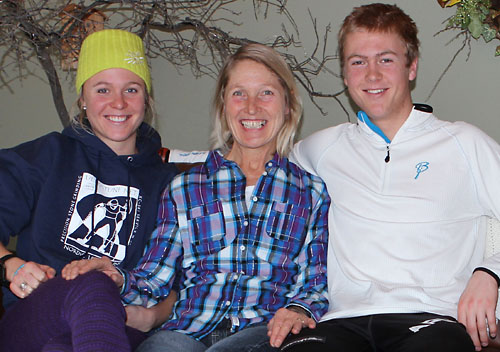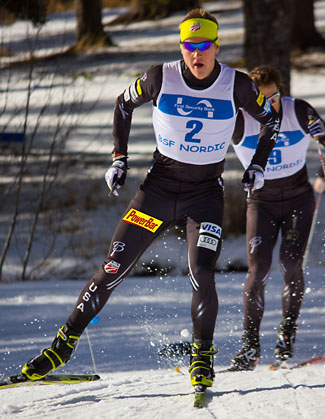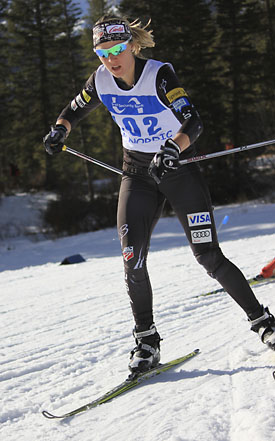home | internet service | web design | business directory | bulletin board | advertise | events calendar | contact | weather | cams

|
Family Effort Sadie and Erik Bjornsen are Methow Valley born and raised – graduates of Liberty Bell High School and the Methow Valley Nordic Team. These days they are college students at Alaska Pacific University, members of the U.S. Ski Team and leaders on the U.S. SuperTour race circuit. And to add one more dollop of home-town pride, they also are competing on the World Cup circuit. In other words, they don’t get home more than two, maybe three times a year, so they are enjoying a Christmas break with their parents, Tom and Mary Bjornsen, and older sister, Kaley, who lives in Seattle. Their parents met and married in Jackson Hole, Wyoming. They were alpine and backcountry skiers who moved to Mazama believing a downhill ski area would be developed at Early Winters. Sadie and Erik started downhill skiing at the Loup as youngsters.  Super-skier siblings Sadie and Erik Bjornsen were home between races to teach their annual Cascade Challenge Ski Camp and to enjoy a family Christmas. Their proud mother, Mary, joins them in this photograph. Photo by Karen West Super-skier siblings Sadie and Erik Bjornsen were home between races to teach their annual Cascade Challenge Ski Camp and to enjoy a family Christmas. Their proud mother, Mary, joins them in this photograph. Photo by Karen WestThey began picking up Nordic skiing as a family activity, Sadie said. “We didn’t know what we were doing; we were on fish scales,” she said, describing the skis they were using. But after the 1998 Winter Olympics in Nagano, Japan, the three Bjornsen kids and the Gregg brothers (Brian and Chad) started skiing for the Methow Valley Nordic Team coached by Laura McCabe. Erik said that by middle school and high school “our whole family was getting more serious about [Nordic] skiing.” Working with coaches like McCabe and her late husband, Sean, Leslie Hall, and Scott Johnston, the Bjornsens said they became more serious competitors and went to Junior Nationals with the local team. After high school, first Sadie, and then Erik, spent a year at the University of Alaska before joining Johnston’s Methow Olympic Development Project. “I discovered I needed to have a whole lot of challenges going on, not just skiing,” Sadie said, commenting on what turned out to be “an average year” of race results. So she enrolled at Alaska Pacific University, as did Erik a year later, where there is a strong Nordic ski program. Being named to the U.S. Ski Team earlier this year means they are provided with wax technicians, race coaches and help with transportation arrangements, but they still have to pay their own travel expenses. If they earn their way onto the A Team (Sadie is on the B team and Erik on the D – development team) and ski their way into the top 30 skiers on the World Cup circuit, their expenses will be covered. For now they rely on what money they can earn - Sadie babysits and Erik works as a painter and on construction jobs - plus the generosity of private donors who support the non-profit Methow Opportunity Fund, and their commercial sponsors. Fischer, for example, provides their skis and Swix their poles. Sadie said the general rule is that it costs $140 a day for housing, food and transportation to ski the World Cups. “The way I look at it is that it’s a challenge,” she said. You have to learn how to sell yourself and that teaches skills that will be good later in the business world. “You have to think of it as a good experience,” she added. Sadie, 23, and Erik, 21, are on full-ride ski scholarships at APU in Anchorage and when on campus, which isn’t often, live together in student housing. The scholarships require they take a full load of courses, which they mostly do online. “We have to wake up at 5 a.m.,” Erik said, because of class start times and the time zones they travel through during the racing season. Online classes “allow us to sign on from all over the world,” he added. Sadie is working toward two degrees, one in non-profit management and another in accounting. Erik’s degree will be in business management. She said they take some in-classroom courses where they get to know their professors, which makes their online classes more personal. The American 'Vibe'  Erik Bjornsen skiing to second place in the SuperTour skate sprint race held in Bozeman, Mont., earlier this season. Photo courtesy Erik Bjornsen Erik Bjornsen skiing to second place in the SuperTour skate sprint race held in Bozeman, Mont., earlier this season. Photo courtesy Erik Bjornsen“It’s a really good time for our sport right now,” Sadie added, referring to the American women led by U.S. skier Kikkan Randall who have achieved international recognition. Randall, who trains at the APU Nordic Center, has been the most successful American Nordic skier ever. She will celebrate her 30th birthday on New Year’s Day. Sadie said Randall inspires her. “It’s really nice [to be able to say] I actually kept up with her for one workout... and to know she’s totally human.” Erik added that there also are a number of strong Canadian men who are raising the sports’ profile. “The Americans have never been really good Nordic skiers,” Erik said. “It’s also exciting,” Sadie added, to watch momentum building for the Americans. And for her personally, fun to have a Norwegian last name and a following in Norway, a country of strong Nordic skiers and home to the reigning women’s world champion. “It’s a fun position to be in that spot to encourage the younger generation... There’s like this vibe on the American team right now.” One manifestation of the “vibe” was how quickly the Bjornsens’ annual Cascade Challenge Camp for the Methow Valley’s young skiers filled this year. The cutoff for the December 23 event was 50 participants, and for the first time the slots filled almost as soon as the sign-up sheet was posted. When they were kids, the Bjornsens recalled, their coaches showed them videos of skiers on the World Cup circuit but they didn’t recognize any of them. This year they could show camp participants videos of themselves skiing World Cup races. They figured the younger athletes might be inspired by having the skiers in the films right there coaching them. Mom, Mary Bjornsen, is athletic but never was part of a ski team. She grew up on a Minnesota grain farm where she said she grew up shy, but was a hard worker. “I drove tractors and combines when I was young,” she said. “I think what makes a good athlete is being taught how to work hard,” Sadie said. “...elite athletes, you have to give up everything else.” Staying Healthy  Sadie Bjornsen racing in the sprint in Bozeman, Montana. She took second place. Erin Phillips photograph courtesy of Sadie Bjornsen Sadie Bjornsen racing in the sprint in Bozeman, Montana. She took second place. Erin Phillips photograph courtesy of Sadie BjornsenThe Bjornsens are only in Anchorage about 45 days a year, their mother said. The rest of the time they are training and traveling. That means “health is always the issue,” she added. The siblings said they take vitamins, try to get their sleep and try never to travel the day of a race. They also observe good eating habits after the race. One of the things Erik said he would explain to the young skiers in Sunday’s camp is that they need to eat right after their workouts. “You have about a 30-minute window” to get the most value from your food, he said. One of Sadie’s secrets to staying healthy is “just not stressing about it. You have to believe you’re going to be healthy.” At the elite level, skiing is a full-time job. The Bjornsens are working out about two hours in the morning and 1 to 1.5 hours in the afternoon just to maintain the fitness levels they built over the summer. “It’s summer that makes the athlete – all the hard work you do in the summer,” said Erik. Sadie, who is vexed by tendonitis in her right foot, said she “spent the whole summer and fall running in the [swimming] pool.” Thus in addition to her maintenance workouts, she is religious about the “body work” she has to do to promote healing. One of Sadie’s lessons for the younger skiers is the importance of “goal setting, even if it’s a goal of eating the vegetables on your plate or being nicer to your little brother.” She said learning to set goals and write them down helps young athletes stay in their sport, especially when they get to high school. She keeps a training log with her strengths and weaknesses listed as well as her goals. “I do want to win a World Cup medal. I need to have that goal be visible,” she added. The Bjornsens agree they have “a closer connection,” as Sadie put it, because they are siblings. “It’s pretty awesome,” Erik added. “We grew up training together.” He said he started beating his sister at skiing in high school because guys can ski faster, but he finds her success “really motivating.” Sadie called Erik’s “relaxed vibe” unique among the men on the Nordic race circuit. “He’s so much more relaxed... and has fun,” she said. Where Next? The Bjornsens will compete at the Jan. 2-8 U.S. National Championships at Soldier Hollow in Midway, Utah. On Jan. 9 they fly to Liberec, Czech Republic, for World Cup competition. They will have one day to fight off their jet lag and preview the course, Erik said. Sadie then travels to France and will be on the World Cup tour the rest of the season. “I have a starting spot through Sochi,” she said. This season’s races in Sochi, Russia, the site of the 2014 Winter Olympics, “will be a trial run for the Olympics,” she explained. The skiers will “live on the mountain” at altitude in what will be the athletes’ village. The chance to preview the Olympic race courses and sample local food, culture and local transportation, will be a great experience, they agreed. In addition, any points earned will count toward the Olympic qualifier.” (The U.S. Olympic Nordic ski team won’t be announced until a few weeks before the 2014 games.) Erik will stay in the Czech Republic for the Jan. 20-27 U23 World Ski Championships for competitors under 23 years of age before joining the World Cup tour about 10 days later. 12/24/2012 Comments
|